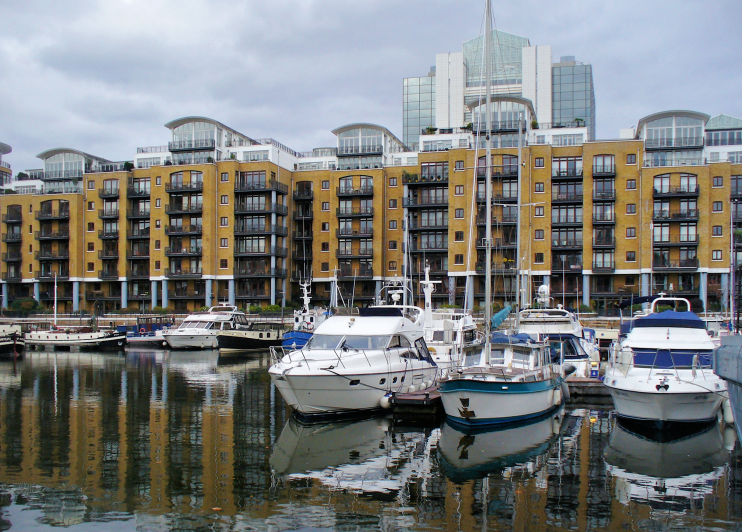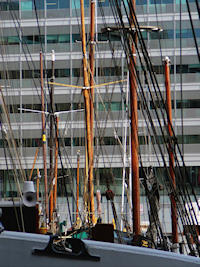St Katharine’s
St Katharine’s, Tower Hamlets
A revitalised part of the former London docks, located between Wapping and the Tower

In 1147 Queen Matilda established a church-cum-hospital that adapted and survived here until the coming of the docks. During the Middle Ages the boggy land was frequently inundated when the Thames wall was breached, but in the early 16th century the marshes were drained by Cornelius Vanderdelft, allowing waterfront development to begin.
The busy settlement that grew up here was torn apart after Parliament passed the St Katharine Docks Act in 1825. Over 11,000 people were displaced by the works, which swept away slums like Dark Entry, Cat’s Hole and Pillory Lane. Construction was led by the great railway builder Thomas Telford, in his only major project in London. Some 2,500 men were employed to move rubble and soil (including the remains from the churchyard) into barges that were then taken upriver by the contractor Thomas Cubitt and used as foundation material for properties in Belgravia and Pimlico. Telford created the docks around two connected basins, giving an exceptionally long quayside for such a small area of enclosed water.
Warehouses were erected on the dockside, with roadways running directly behind – another innovation, which reduced handling and pilferage. St Katharine Docks opened in October 1828 and the last of the warehouses was completed the following year. Additional warehousing was constructed in the 1850s.

With its tight security, St Katharine’s specialised in high-value exotic goods such as ivory, indigo powder, shells and feathers, as well as handling staples like tea and wool. The docks were wrecked by wartime bombs but limped on until their final closure in the late 1960s.
In the 1970s and 1980s St Katharine’s was redeveloped in a pioneering mixed-use project that created private and public housing, offices and leisure facilities. The Dickens Inn was fabricated in antique style around the innards of a relocated warehouse, and a retracting footbridge was added at the entrance to the centre basin in 1994. With its yachts, cobbled causeways, cafés and shops St Katharine’s is a tourist attraction by day, while the bars and restaurants draw City workers at night.
Like many other Docklands quarters, the neighbouring housing displays a great disparity in wealth between its newcomers and the more established inhabitants. The area’s ranking on the ‘deprivation index’ is falling, but some residents remain in disadvantaged circumstances.
Postal district: E1
Population: 12,411 (St Katharine’s and Wapping ward, 2011 census)
Riverboat pier: St Katharine’s
Website: St Katharine Docks
